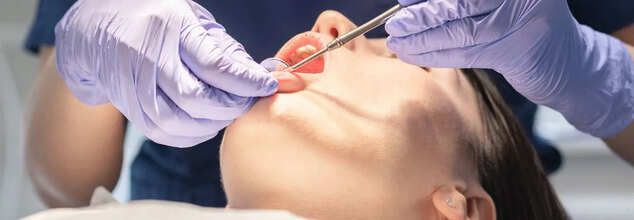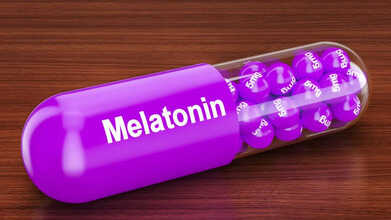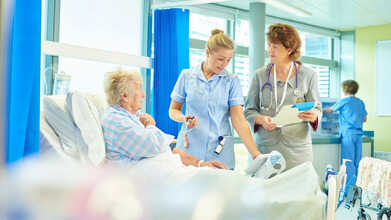- Health Conditions A-Z
- Health & Wellness
- Nutrition
- Fitness
- Health News
- Ayurveda
- Videos
- Medicine A-Z
- Parenting
Is It Possible To Regrow Teeth In Humans?

Credit: Canva
Every year, dental spending adds up to over $120 billion nationally across US. The story is similar in other parts of the world. A large portion of this money goes toward fixing or replacing teeth. Procedures such as cavity fillings, dental crowns, and tooth-loss solutions like dentures and bridges can be costly. Fortunately, they might not be necessary in the future.
Is It Possible To Regrow Teeth In Adults?
Research done on stem cells have allowed scientists to grow tooth pulps in dogs. A study published in Journal Of Endodontics involved twelve mongrel dogs and their 192 posterior teeth (16 teeth per dog) from the upper and lower jaws. Partial pulpotomies were performed, and the dogs were divided into two equal groups of six. In Group 1, 96 teeth had their coronal pulp cavities filled with a calcium silicate–based capping material. Meanwhile, in the second group, 96 teeth were treated with bone marrow stem cells (BMSCs), followed by the same calcium silicate–based capping material. Both the groups were then analysed for the amount of inflammation, tissue damage, and the thickness of newly formed hard tissue. Researchers observed a significant difference in hard tissue bridge formation between the two groups at both the 1-week and 9-week evaluations, triggering hopes that stem cells could probably be used for regenerating teeth in future.
Brushing Is Important To Dental Health But Be Careful
While regular brushing is the most important step in maintaining a good dental hygiene, to much brushing can lead to erosion of enamel. Excessive brushing of your teeth can result in a range of issues like enamel erosion, tooth sensitivity and even permanent damage. Improper brushing, combined with highly acidic foods and drinks, can lead to serious dental problems.
Overbrushing or brushing using an improper technique can also extensively damage your teeth. Using a hard toothbrush in a horizontal manner can lead to a problem called abrasion that can directly contribute to enamel erosion, particularly near the neck of the tooth on the cheek side. Dental Erosion, tooth erosion or enamel erosion can be caused by a range of chemical or mechanical forces. The process happens slowly, but it is important to be treated as it can lead to wear away underlying layers of your teeth. It can cause the teeth to become smaller, more sensitive and prone to pain.
How To Properly Brush Your Teeth?
In order to prevent abrasion, dentists recommend using a medium or soft toothbrush along with a minimal abrasive toothbrush. They also suggest that instead of brushing in a horizontal manner, one should use a "Bass technique" or "Modified bass technique" which is gentler on teeth.
As per the Bass technique, one should hold the toothbrush at a 45-degree angle place the bristles slightly over the gum line and gently brush for 15 to 20 minutes in circular motion. Gently flick the bristles towards the biting surface to remove the plaque and then continue to the next tooth.
ALSO READ: Dental Health: Can Overbrushing Damage Your Teeth?
What Time Is Blood Pressure Usually Highest? Here Is What Cardiologists See Most Often

Credits: Canva
Blood pressure shifts throughout the day in a steady rhythm shaped by hormones, activity, and the body’s internal clock. Doctors call this the circadian pattern of blood pressure. It helps the body prepare for wakefulness, support daytime tasks, and recover during sleep.
While this rise and fall is normal, the timing of these changes matters, especially for people with hypertension or heart conditions. Dr Sunil Rana, Associate Director and Head of Internal Medicine (Unit III), Asian Hospital, explains how these variations unfold across a typical day.
Why Blood Pressure Peaks in the Early Morning
In a normal cycle, the highest readings appear between six in the morning and nine in the morning. This is the point when the body shifts from sleep to wakefulness. Hormones such as cortisol and adrenaline surge during these hours. They raise the heart rate and tighten blood vessels to help the body feel alert.
Dr Sunil Rana said, “This rise is natural, yet it carries added importance for people with hypertension, diabetes, sleep disorders, or heart disease. During these early hours, the risk of heart attack, stroke, and other vascular complications is known to be higher because the body is under greater strain.”
How Daytime Habits Shape Midday and Afternoon Readings
After the morning peak, blood pressure usually settles into a moderate range through the late morning and early afternoon. Daily tasks like walking, working, travel, and problem-solving maintain a steady level. At the same time, several routine triggers can push these numbers higher. Mental stress, dehydration, caffeine, skipped meals, and long periods of sitting often raise readings through the day.
Dr Sunil Rana, told us that people who face chronic stress, irregular work hours, or disrupted eating patterns tend to see wider swings. Toward late afternoon, blood pressure usually dips slightly as the body begins to wind down. However, heavy meals, alcohol, emotional tension, or intense workouts in the evening can cause short-lived spikes.
Why Blood Pressure Falls at Night?
During sleep, the body enters a quieter phase known as nocturnal dipping, where blood pressure typically drops by ten to twenty percent. This drop gives the heart and blood vessels a chance to rest. The dip is an important part of cardiovascular recovery.
Dr Sunil Rana said, “Not everyone experiences this nightly reduction. People with kidney disease, diabetes, sleep apnea, or autonomic dysfunction may show little or no dip at night, which is linked to a greater risk of long-term heart problems. Irregular sleep routines, late-night screen use, and chronic insomnia can also disrupt this natural decline and keep nighttime readings higher than expected.”
Factors That Influence These Daily Changes
The steepness of these fluctuations differs from person to person. Age, lifestyle, food habits, alcohol, smoking, weight, and stress all play a part. Night-shift workers may show the reverse pattern, with pressure rising at night instead of morning. Medication timing also shapes the curve, especially in people who take antihypertensive drugs.
Doctors often advise checking blood pressure at different times of the day, including early morning and before bedtime, to understand a person’s individual rhythm more clearly.
Understanding that blood pressure is naturally highest in the early morning helps in planning treatment and daily routines. It guides medication timing, supports healthier morning habits, and strengthens long-term control. It also helps people at higher risk take steps to protect their heart during the hours when it needs the most support.
Melatonin Overuse: Side-Effects, Long-Term Risks, And How To Use It Safely

Credits: Canva
Melatonin has become one of the most widely used sleep aids in recent years. Many people rely on it to manage jet lag, night-shift sleep cycles, or occasional insomnia. Surveys show that a large share of adults have tried melatonin at some point, often assuming it is completely harmless because it is available over the counter.
In most cases, short-term use is safe, but a growing number of emergency calls and medical reports show that misuse and high doses can cause real problems, especially when taken without guidance.
We got in touch with Dr Lohit Kumbar, Endocrinologist at SDM College of Medical Sciences and Hospital in Dharwad, who explained how melatonin overuse affects the body, the long-term concerns linked to prolonged use, and the safest way to take it.
How Melatonin Overdose Affect the Body?
Melatonin is produced naturally by the pineal gland at night. It plays a central role in sleep regulation, but it also influences blood pressure, body temperature, and the body’s antioxidant activity. Dr Kumbar told us, supplements mimic this natural hormone and are often used for insomnia and several neurological or developmental conditions, including Alzheimer’s disease, autism spectrum disorder, and mild cognitive impairment. Because it supports these functions, many assume that more melatonin means better sleep, which is not true.
Dr Kumbar notes that even though melatonin is generally safe, high doses can cause immediate discomfort. The most common signs of excess intake include daytime sleepiness, headache, dizziness, nausea, and sleep disturbances. These symptoms usually appear when the dose goes beyond 10 mg per day, which is far above what most people need. In a few rare situations, more serious reactions have been reported. These include autoimmune hepatitis, confusion, optic neuropathy, psychotic episodes, seizures, and unusual skin eruptions. Such cases are linked to a wide range of doses, from as little as 1 mg to as high as 36 mg, suggesting that individual sensitivity varies.
Melatonin Long-Term Risks You Should Know About
While overdose symptoms appear quickly, long-term risks build up slowly. Prolonged melatonin use, especially over six months or more, may affect reproductive hormones. According to Dr Kumbar, this can lead to reproductive dysfunction, delayed puberty in younger users, and concerns about fetal development if the supplement is taken during pregnancy. These risks are not yet fully understood, largely because long-term data is limited, but the existing evidence is strong enough for doctors to urge caution.
Pregnant and breastfeeding women, in particular, are advised to avoid melatonin unless a doctor specifically recommends it. Children and adolescents should also use it only under strict medical guidance.
How to Use Melatonin Safely
Safe use begins with sticking to the lowest effective dose. Dr Kumbar recommends keeping daily intake at or below 5 to 6 mg. Most adults respond well to even smaller amounts, and higher doses do not improve sleep quality. If melatonin becomes a regular part of your routine, medical supervision is important. A doctor can help determine the right dosage, ensure there are no interactions with other medicines, and monitor any side effects.
Melatonin can be helpful when used responsibly, but it is not a cure-all for sleep problems. Understanding the risks of overuse ensures you protect your long-term health while still getting the rest you need.
Flu Cases In The UK Are Rising Fast This Year—Here’s What Is Making It Worse

Credits: Canva
NHS Flu Cases: Flu season has arrived far earlier than expected this year, and hospitals across England are already seeing a sharp rise in cases. The latest figures show that the number of patients admitted with flu is more than 50 percent higher than the same week last year. During the week starting 24 November, an average of 1,717 people were in hospital with flu each day, including 69 who needed critical care, as per The Independent.
In the same week last year, the total was 1,098 patients, with 39 in critical care. These numbers follow recent warnings from the NHS, which urged vulnerable groups to get their flu jabs as early as possible, as experts fear this could turn into one of the most challenging winters in recent memory. This raises several key questions. What is driving this sudden surge, how severe could the coming months be, and how much protection can the vaccine offer?
NHS Flu Cases: What’s Causing The Flu Surge?
Specialists suspect an altered form of influenza A is behind the early rise in cases. They observed Australia’s recent flu season, which often gives a hint of what lies ahead for the UK, and saw record-breaking infection levels. Alerts also came from the Asia-Pacific region, where Japan announced a flu epidemic in October and schools were temporarily closed.
Flu viruses fall into three groups: influenza A (H1N1), influenza A (H3N2), and influenza B. This year, the main culprit is the H3N2 strain. Flu viruses constantly change through a process called antigenic drift, which is why vaccines are updated each year. In the Northern Hemisphere, the strains for the upcoming winter season are chosen in February.
However, this particular H3N2 strain, known as subclade K, changed more rapidly over the summer and is now considered significantly different from the strain used in the current vaccine, according to the UK Health Security Agency (UKHSA). After reviewing the latest NHS numbers, Sarah Woolnough, chief executive of The King’s Fund, noted that the flu season has “not yet peaked,” adding that it is still uncertain how long this early surge will last.
NHS Flu Cases: How Bad Is It?
Health experts fear that thousands of people could lose their lives this winter. Flu-related deaths more than doubled last year, with the UKHSA estimating 7,757 deaths in England, compared with 3,555 the year before. Deaths among children also rose from 34 to 53. Senior NHS leaders have warned of a very difficult winter ahead. In November, NHS England chief executive Jim Mackey said staff may face “one of the toughest” seasons yet.
He admitted that the prospect of a long, heavy flu season had been a major concern, and current trends suggest that these worries were well founded. Australia recorded its worst flu season on record, with more than 410,000 cases, and the expectation is that the UK may face similar patterns. He added that from December through March, hospitals will likely run at full capacity.
NHS Flu Cases: How Effective Are The Vaccines?
The UKHSA has analysed how well this year’s vaccine is performing by examining whether vaccinated people are less likely to be admitted to hospital with flu. Early assessments show that the vaccine is offering around 70 to 75 percent protection against hospital attendance in children aged two to seventeen, and around 30 to 40 percent protection in adults.
Dr Jamie Lopez Bernal, consultant epidemiologist for immunisation at UKHSA, said he remains confident that the vaccine will provide important protection for those most at risk, regardless of which strain becomes dominant. He explained that practising good respiratory hygiene and reducing contact with others when symptomatic can also help lower transmission. According to NHS England, 14.4 million flu vaccines were administered during the autumn, which is more than 160,000 ahead of the same point last year.
NHS Flu Cases: Should You Get A Flu Vaccine?
Flu vaccinations are free and advised for several groups, including:
- Everyone aged 65 and above
- People under 65 who fall into clinical risk categories
- Residents of care homes and their carers
- Pregnant women
- Close contacts of people who are immunosuppressed
- Frontline health and social care workers
- Children
Vaccinations began in October, but anyone eligible can still get their jab until 31 March.
You can get vaccinated by:
- Making an appointment with your GP surgery
- Booking a free NHS flu jab at a pharmacy through the NHS website or app
- Visiting a pharmacy that offers walk-in NHS flu vaccinations if you are 18 or older
As of 23 November, 69.6 percent of people aged over 65 had received their jab. Uptake was lower in other groups, including adults under 65 with long-term health conditions (35.1 percent), pregnant women (33.9 percent), and children aged two (39.8 percent) and three (40.3 percent).
© 2024 Bennett, Coleman & Company Limited

